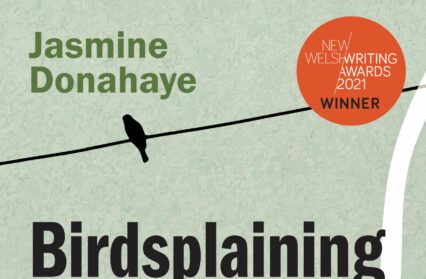Zoe Kramer reviews Birdsplaining: A Natural History, by New Welsh Writing Awards 2021 winner, Jasmine Donahaye. This exploration of women’s experience of nature, and the constraints placed upon it, takes in Wales, Scotland and California on its quest to offer a new way to engage with the natural world.
I must confess to an abysmal ignorance about birds. Sometimes a bird will swoop or flutter its way into my attention, but for the most part they exist in my periphery. I don’t think I could name more than a dozen species. My understanding of them is murky, full of gaps, incomplete. I was surprised, however, to find my uncertainty matched by the author from the very beginning of Birdsplaining. Donahaye does not claim to be an expert or an authority on birds. Nevertheless, her experiences and accounts of the curious ways birds can subvert expectations are masterfully insightful, and provided understanding the likes of which I have never found in a field guide.
As the title suggests, the book deals in part with the inequalities in the field of birdwatching. It touches on a tendency for men to place themselves between others and the natural world, to take it upon themselves to impart knowledge or point out a rare sighting, rather than to let others find it for themselves. Equally, it wanders through the history of the field, the boys club ethos and the ways that female birds have been recorded as an afterthought compared to males of their species. But this is far from the only power imbalance in the field; Donahaye describes the particular experience of racial othering that happens in rural spaces. She also draws upon the history of colonialism to interrogate the shortcomings in the ways birds have been categorised and named. Birdsplaining acknowledges both the importance of drawing awareness to power imbalances, and the potential for an alternative to exercising authority in discussions of the natural world.
Donahaye does not shy away from the parts of nature that are unglamorous, uninspiring or unpleasant. Rather, she actively seeks them out and gives them the spotlight. She describes the process of decay in a ewe’s leg, her loathing of wasps, the slaughtering of a deer. She probes the idea of how far we will allow nature into our homes to share our spaces, and what it is that we are guarding these interiors from. Contemporary concepts of dirtiness are examined with curiosity: animals, despite exhibiting behaviours of self-cleansing, are seen as living in squalor. Disgust, she posits, is always learned.
Building on this concept, Donahaye also pulls at the troublesome thread of the tragedy of the commons and wildlife tourism. The conservation spectacle, often touted as a way to secure public interest and funding, seems to exist at times only for its own sake, and doing little to inspire actionable change. Wildlife tourism offers guaranteed sightings, an experience of nature to be consumed and demanding little of the viewer. At the same time, she acknowledges an elitism and privilege inherent to this birdwatching “purism.” Is the correct way to experience nature the least accessible one? It is not a question which incurs easy answers, yet Donahaye examines it in all its complexity.
Birdsplaining is a fresh way of looking at nature writing, a deeply personal account that embraces its own subjectivity. It refuses to be dispassionate in its exploration, seeking out moments of vivid and dynamic experience of the natural world. Donahaye’s inquisitive humour and astute observations make it an excellent read for birdwatchers and layfolk alike.











